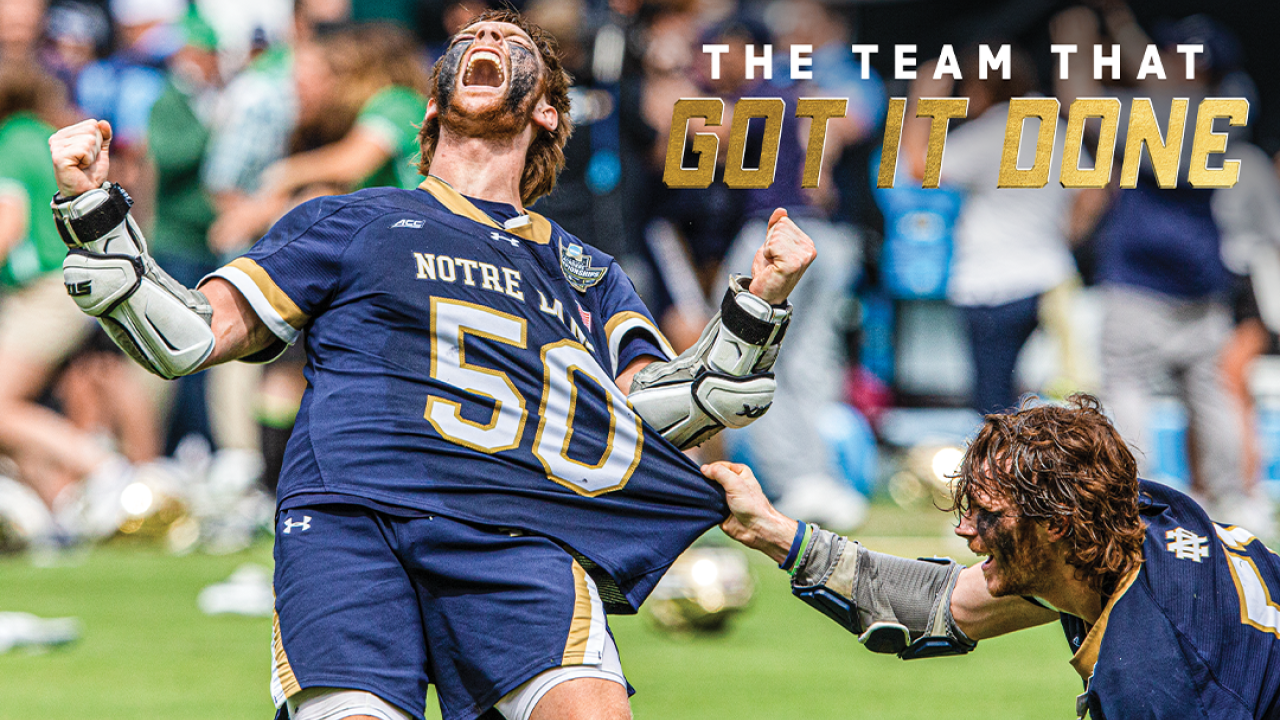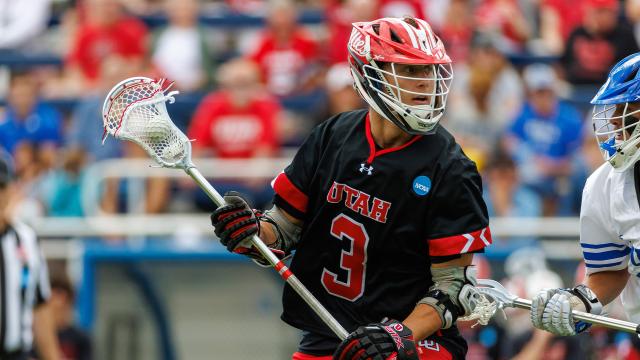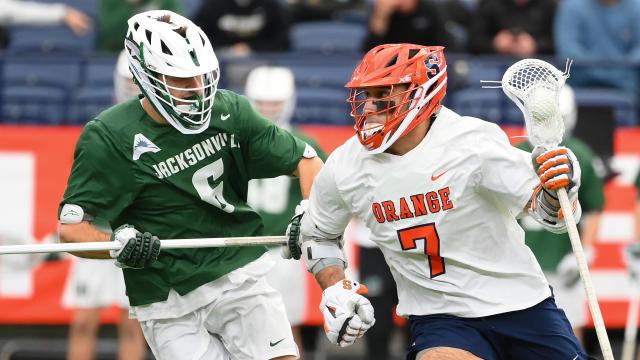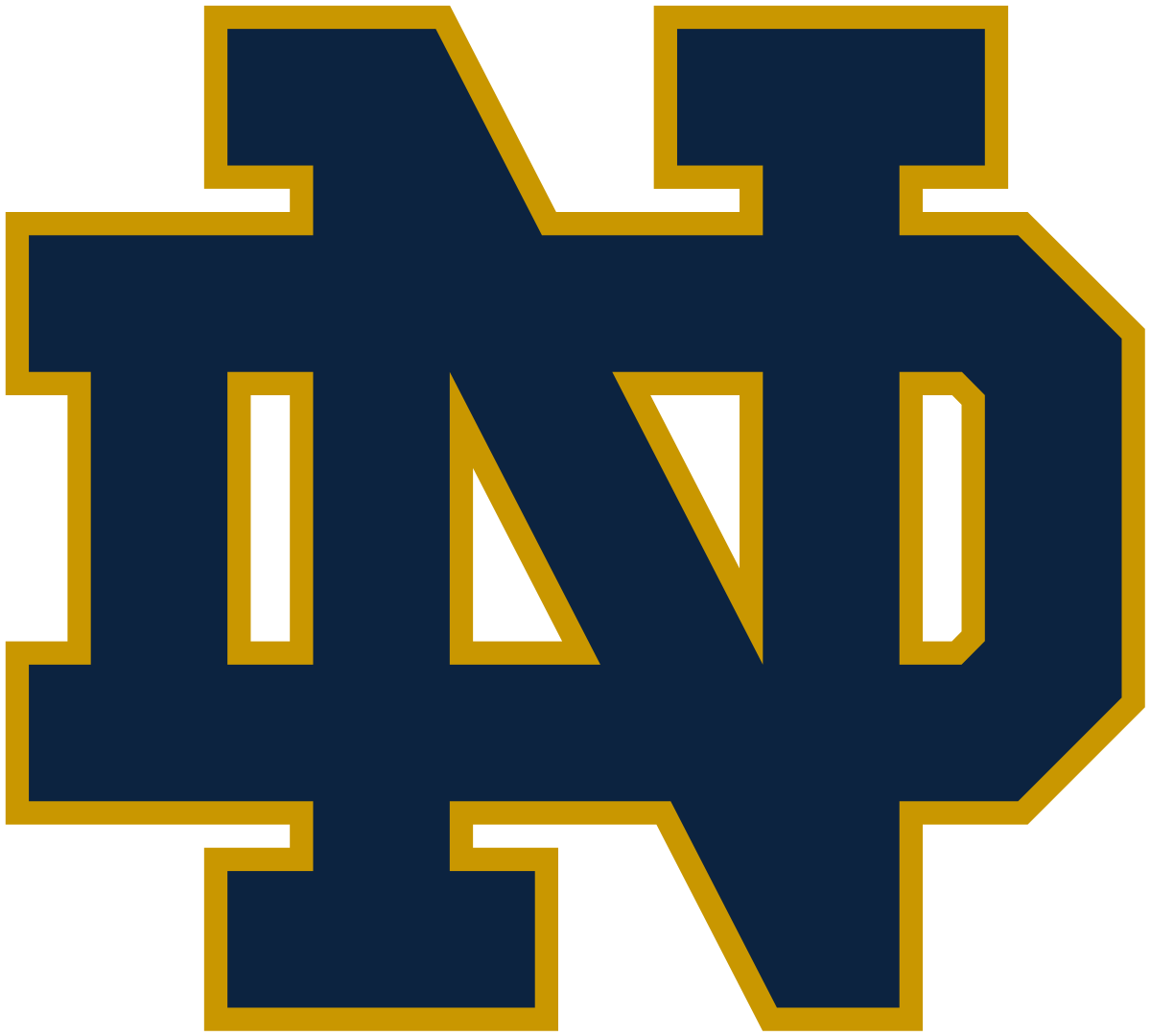
The Team That Got it Done
Pat and Chris Kavanagh pulled themselves up from the field to the front row of Section 118 at Philadelphia’s Lincoln Financial Field, embracing the rest of their family and letting out what seemed like years’ worth of exaltation. “We did it! We did it! We did it! I can’t believe it,” Chris Kavanagh said as he hugged his brother, Brendan, and sister, Colleen.
Notre Dame coach Kevin Corrigan stood on the grass field, soaking it all in — both the feeling of winning his first national title after 35 years and the chill of a Powerade shower his players just gave him. He turned to find Liam Entenmann, who was just named the NCAA champi.onship’s most outstanding player. They hugged and reminisced about when Corrigan’s chair just happened to be turned in the right direction on a sunny Philadelphia weekend in 2017 — where he saw a raw but talented goalie from the Long Island Express at a high school sophomore showcase event.
“I’m really happy you turned your attention to my field that day,” Entenmann said. “I wouldn’t be here without you.”
“I’m so proud of you,” Corrigan replied.
In the chaos that ensued after the clock hit 0:00 was a common theme — elation mixed with relief. Notre Dame had its share of disappointment in May. Losses to Duke on Memorial Day in 2010 (in overtime) and 2014 proved par.ticularly painful for the Fighting Irish.
On May 29, 2023, their suffering ended. Notre Dame defeated Duke 13-9 in front of 30,462 fans in the stadium and more than 757,000 people watching on ESPN2, joining Denver (2015) as the only schools not on the Eastern sea.board to win the NCAA Division I men’s championship.
GROWING UP IN CHARLOTTESVILLE, VIRGINIA, IN THE 1960S, Corrigan seldom went straight home after school. Most days, the Charlottesville City Public School bus dropped him off at the lacrosse field at Virginia.
The son of National Lacrosse Hall of Famer Gene Corrigan, he grew up watching his father coach the Cavaliers. He and seven siblings were born into a lacrosse family, even when the sport wasn’t popular in Charlottesville.
“I’ve been around this game for a long time,” Corrigan said. “My brothers and I were the only kids in town with lacrosse sticks.”
He played on one of Albemarle High School’s first lacrosse teams before committing to play for his hometown Cavaliers and another Hall of Fame coach, Jim “Ace” Adams. His first experience falling one game shy of a national title came in 1980. Virginia lost in double overtime against Johns Hopkins in the NCAA final at Cornell.
Following stops at Randolph-Macon and Virginia (as an assistant) Corrigan was named head coach at Notre Dame in 1988. Gene Corrigan was the athletic director there before becoming ACC commissioner and NCAA president.
“He lived and died with our games,” Corrigan said. “My brothers and sisters say, ‘On game days, you're the favorite. There's no doubt about that.’”
Notre Dame made its first NCAA tournament appearance in 1990 and advanced to its first final four in 2001. Luminaries like Todd Rassas, Tom Glatzel, D.J. Driscoll, the Kemp brothers and Scott Rodgers set the table for current pros like Matt Kavanagh, Jack Near, Matt Landis, Sergio Perkovic, Garrett Epple and Ryder Garnsey.
The highs — like Matt Kavanagh’s OT winner to get past the Thompson brothers and Albany in the 2014 NCAA quarterfinals — too often were overshadowed by setbacks. Like Duke’s CJ Costabile taking the OT faceoff to the rack against Rodgers to win it all in 2010.
Duke also got the better of Notre Dame in the 2011 and 2013 quarterfinals, the 2014 final, and the 2019 quarterfinals (in overtime). The Fighting Irish also fell to eventual national champions Loyola and Denver (in overtime) in the 2012 and 2015 semifinals and North Carolina and Maryland (in overtime) in the 2016 and 2021 quarterfinals, respectively.
After winning six straight games leading into Selection Sunday last season, Notre Dame was left out of the NCAA tournament altogether.
“Did last year motivate us and galvanize this team? Absolutely. Revenge is not the right word, though,” Corrigan said. “We’re not going to blame other people. We’re going to say from this moment forward, let’s do what we can do to make sure this doesn’t happen to us again next year. I don’t think that’s revenge. That’s accountability and owning up to what you had control of, and that’s what our guys did. That’s why I’m so proud of them.”
In 2023, Notre Dame left no doubt. The Fighting Irish rolled through everyone not named Virginia in the regular season. After clobbering Utah and smothering Johns Hopkins the first two weekends of the NCAA tournament, they took the third and most meaningful meeting with Virginia on Tevlin’s winner — in overtime.
Two days later, Corrigan could finally celebrate with his team and family. “It was a little divine intervention,” said Lis Corrigan, his wife. “The tailgate had five decades of kids. There is one connecting thing, and it’s Kevin. He’s deserved this for a long time.”
Kevin Corrigan could not help but think of someone who wasn’t there. His father, Gene, died in 2020. “I wish my dad was here to share it with us,” Corrigan said.
CHRIS KAVANAGH RAISED A POSTER as high as his 10-year-old arms could reach. “#50 is my BROTHER!” the sign said.
Chris and Pat Kavanagh with the number 50 painted on their faces watched from the stands as their brother, Matt, played in the NCAA final on May 26, 2014. They idolized him and threw behind-the-back passes at team barbecues. The brothers’ awe turned to disappointment, however, after Jordan Wolf led Duke to an 11-9 victory over Notre Dame.
“Chris snapped the sign in half when we lost,” said his mother, Mary Kavanagh. “I wanted to save it because it was a special sign.”
“I’m pretty sure he was angrier about it than I was,” Matt Kavanagh said.
Mary Kavanagh wanted the sign as a keepsake. She didn’t know at the time a replica would be necessary. Colleen Kavanagh — the lone girl among the five Kavanagh siblings — took it upon herself to make a new one in May. On one side, it said, “#50 is my brother!” On the other, “#51 is my brother!” Matt Kavanagh held the sign proudly.
“Knowing what we had been through, trying to get that first championship under Coach Corrigan, it would have been so special,” Matt Kavanagh said. “This time, knowing that Pat and Chris were along for the ride with us and now I was in their shoes, it was pretty amazing.”
Pat Kavanagh dragged Chris Kavanagh to the ground and both let out a roar after the buzzer sounded at Lincoln Financial Field.
“The best memories of my childhood were watching Matt play at Notre Dame,” Pat Kavanagh said. “To get it done with my little brother, who’s been my best friend since he was born, it’s special.”
The brothers looked like they were in a street fight. Chris Kavanagh traded face paint for six stitches just below his left eyebrow — the product of a hit to the head against Virginia — and excessive eye black. Pat Kavanagh had a dark blue elastic TheraBand wrapped around his badly bruised left hamstring. Athletic trainer Mandy Merritt consulted with colleagues from the U.S. national team to devise a plan.
The band served as an artifcial hamstring, pulled as tightly as possible from his calf to his thigh to give him flexion. It was delivered from Baltimore the morning of the championship game and handed to Kavanagh through the window of the team bus.
“Pat’s a warrior and he was always going to play,” Merritt said. “The Kavanaghs are like hockey players. Spit the tooth out and keep going.”
The injury relegated the Tewaaraton Award finalist to a limited role as a decoy, albeit one who kept Duke’s first-team All-American defenseman Kenny Brower occupied throughout the game.
Entenmann admired Matt Kavanagh’s fearless dodging, relentless riding and scrappy ground ball play as a Notre Dame fan growing up. Now he sees the same in his brothers.
“I love watching them just fly around the field and chase guys down,” Entenmann said. “It’s like they have a personal vendetta against them. They never stop.”
They share the clutch gene. After Duke rallied from a 6-1 deficit to tie the game at 7 late in the third quarter, Pat Kavanagh threaded a pass through traffic that Tevlin deposited to put Notre Dame back up by one. Twenty-seven seconds later, Chris Kavanagh ducked underneath Blue Devils defender Aidan Maguire, dove in front of the goal mouth and tucked a shot across his body inside the near pipe to beat the buzzer.
Duke never got any closer than that.
This article appears in the July/August edition of USA Lacrosse Magazine. Join our momentum.
Matt Hamilton
Matt Hamilton is the Content Marketing Manager at USA Lacrosse, having served as a staff writer for four years. He's a Baltimore native who loves the Orioles and Ravens, even if they let him down in the last year. He likes chicken tenders and Shirley Temples and sick views. He also loves writing about lacrosse.

Related Articles




